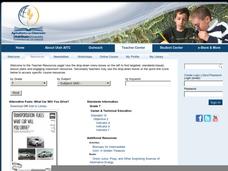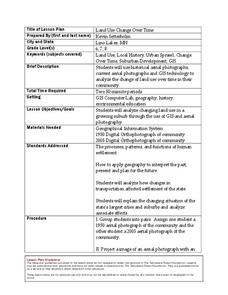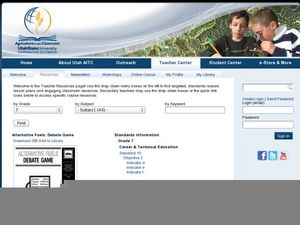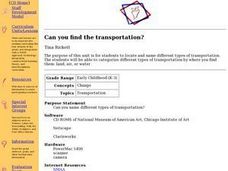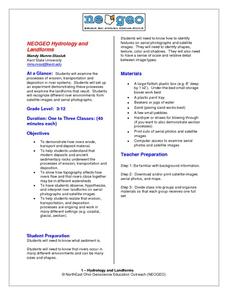Teach Engineering
Airplanes Everywhere: Land! Water! Sky! Oh, My!
How important is aviation? Using the background information, teachers provide the class with a brief history of aviation. The class discusses how airplanes are important to the area of transportation in the 17th installment of a...
Curated OER
Transportation Fuels: What Car Will You Drive?
How many different types of biofuels are out there? Seventh graders watch a series of videos and participate in a series of activities in order to better understand all the transportation options available. They consider what type of car...
Curated OER
Future Transportation
Third graders research various types of land, sea, and air transportation, including current modes and those anticipated in the near future. They imagine future types of transportation and predict where they might travel in these vehicles.
Curated OER
How Should Our Gardens Grow?
Students examine different types of land use by humans and evaluate the ways land is used in their local community. They also consider the environmental effects of the different types of land use. Students assume the role of community...
Curated OER
This Land Is Your Land, This Land Is My Land
Young scholars review and evaluate the ways land is covered and used in their local community. They consider the environmental effects of the different types of land use. Students act as community planning engineers to determine where to...
K12 Reader
Using Land in Different Ways
After reading about rural, urban, and suburban land use, readers respond to a series of comprehension questions using evidence from the provided passage.
Curated OER
Transportation Memory Game
In this memory game worksheet, students match the pictures showing means of transportation including air, water, and land. Students 18 pictures.
Curated OER
Land Use Change Over Time
Learners use historical aerial photographs and current aerial photographs to compare the change over time to the land. For this land changing lesson plan, students analyze, compare, contrast, and list the land change in their own community.
Curated OER
Transportation
Second graders discuss different types of transportation and find pictures that would fit in these categories: land, air, and water. They will then write about their favorite type of transportation in each category.
Curated OER
Transportation
In this transportation types worksheet, students study the images of the vehicles in each box. Students circle the vehicle that does not belong in the box. Students also sort the vehicles into the proper category: land, air, and water...
Curated OER
Career & Technical Education: Grade 7
Educate your learners on the importance of using bio-diesel as an alternative transportation fuel. Provided here are several links to books (with reviews), a 24-page informational text in three reading levels, a corn activity, and...
Curated OER
Alternative Fuels: Debate Game
Seventh graders play a debate game as they explore the concept of alternative transportation fuel. They evaluate the advantages or disadvantages of using biofuels. Multiple resources, such as videos, PowerPoints, and websites are...
Carnegie Mellon University
Understanding Electricity Mix Tradeoffs
Use the accompanying presentation and colorful technology sheets to introduce your class to the 10 different energy technologies. Connect kids to an interactive computer tool that allows them to combine different types of power...
Curated OER
Can you find the transportation?
Students locate and name different types of transportation. They categorize types of transportation by where you find them: land, air, or water. Students graph the information collected. Additional ideas are listed for cross curriculum.
Curated OER
Transportation
Students explore basic transportation vehicles, specifically air, land, and water vehicles, name six different modes of transportation, identify four different kinds of train cars, and three differences between two different modes of...
Curated OER
Chemistry World The Five Types of Chemical Reactions
Learners research five types of chemical reactions in order to design a learning center. Students use technology to research and present their material.
Curated OER
Landforms of Illinois
Fifth and sixth graders are introduced to the primary landforms of Illinois and discover how they were created. Landform cards are made for each pupil. They use the twenty-questions format until they have identified each one. Then,...
Curated OER
Children's Literature Across the Curriculum Ideas-The Wheels on the Bus
Students read The Wheels on the Bus by Maryann Kovalski. They complete a variety of cross-curricular activities surrounding the study of travel and transportation. Included are reading, art, math, science, writing, social studies, and...
Houghton Mifflin Harcourt
Off to Adventure!: English Language Development Lessons (Theme 1)
Give language skills a boost with a series of ESL lessons in an Off to Adventure! themed unit. Using a speak, listen, move, and look routine, scholars enhance proficiency through grand conversation and skills practice. Discussion topics...
Curated OER
The Work of Waves and Wind
This is not revolutionary, but it is informative. Earth science viewers in grades 7-12 get carried away with wave and wind erosion. They view diagrams of how waves impact ocean shorelines. They see examples of the different types of sand...
Curated OER
Transportation
Students learn all about how people and products get from place to place.
Curated OER
Types of Trains
Third graders explore different types of trains. In this science lesson, 3rd graders study the "Orphan Train" and write a paragraph about what it would feel like to be riding a train during this time period.
Curated OER
Mapping West Virginia
Fourth graders explore West Virginia. In this Unites States geography lesson, 4th graders discuss the type of land and the cities in West Virginia. Students create two overlays, with transparencies, that show the natural land and the...
NorthEast Ohio Geoscience Education Outreach
Hydrology and Landforms
Three days of erosion exploration await your elementary geologists. Learners begin by examining rivers via Google Earth, then they model water flow in sand, and finally, they identify resulting landforms. This lesson is written...



